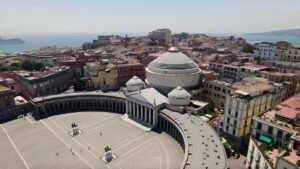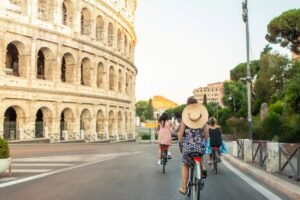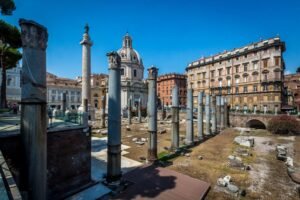Most Beautiful Rome attractions | Explore the top Picks

Rome, the city where hope springs eternal. It is a city proud of its ancient, glorious heritage, the heart of a civilization that once expanded its empire across Europe, Africa, and Asia. Rome is drenched in history and Christianity. First-time visitors may easily feel overwhelmed by all the magnificent city has to offer.
After all, history and art are found on nearly every street corner. That’s why visitors may want to do some research to narrow down what they want to see and do before boarding a plane bound for the Italian capital.
After all, one can find history and art on almost every street corner. That’s why visitors may want to do their homework to narrow down what they want to see and do before they get on a plane bound for the Italian capital.
Number 10: Galleria Borghese
The Galleria Borghese is an art gallery that was built as a party house by Cardinal Borghese in the 17th century.
A nephew of Pope Paul V, the cardinal was also a patron of the arts. The galleria today houses many paintings, sculptures, and other antiquities from his collection. Paintings by Titian, sculptures by Bernini, and the National Museum of Musical Instruments can be seen here.
When he was elected Pope in 1605, Paul V decided to transform some land that he owned just outside the city of Rome into a villa, a suburban villa located outside the city proper, and to use that structure for relaxation, a place to get away from the stresses of urban living.
He asked his nephew, Cardinal Scipione Borghese, to assemble the world’s greatest art collection, and Scipione did not disappoint. In fact, the collection of the Borghese is still housed today in that building that you see behind me, the Borghese Gallery, which is my absolute favorite museum in the entire city of Rome.
This building holds more than just art. There are the secret gardens to the left and right, the aviaries that you see as well, where they had a collection of rare birds, silkworm farms, and dovecotes. This place was what the Borghese liked to call the “theater of the universe,” where they could come to enjoy this great collection of esoteric and beautiful things and show off to the world what a great family they were.
But the term “villa” does not refer only to the building, but to the entire park that surrounds it, where today, Romans come to jog, walk their dogs, and simply enjoy a bit of greenery in the very heart of their city—the Villa Borghese, the great lung of the city of Rome.
Number 9: Piazza Navona
One of the most famous of Rome’s many squares, Piazza Navona was established towards the end of the 15th century and preserves the shape of a Roman stadium that once stood here. The buildings surrounding the square stand where the spectators once sat. Today, the square features no less than three magnificent fountains and is an immensely popular place to sip a cappuccino, shop, and watch street performers.
Piazza Navona in the Campo Marzio. What we have here in the floodplain of Rome is this incredibly well-preserved shape from Rome’s ancient Greek stadium. It was originally built, as we understand from the ancient sources, in wood by Augustus and then rebuilt at the end of the first century AD in stone by Emperor Domitian.
Now, all those buildings around the edges are sitting on top of the remains of the seating—seating for 30,000 spectators. So, what you’re seeing today is nothing compared to the roar of the crowd watching foot races, wrestling, and so forth. This was not Rome’s number one venue, of course; we have the Circus Maximus and the Colosseum, but it was up there. It still remains today one of the most famous piazzas in the world. Why? Because of its unique shape, based on its ancient remains.
Number 8: Castel Sant’Angelo
Castel Sant’Angelo was built to be a mausoleum for Emperor Hadrian and his family. Built in 123 AD, it was later turned into a fortress and castle by the popes. It was once Rome’s tallest building. The ashes of other emperors were buried there but were scattered when the Visigoths invaded in 410.
It also served as a prison, but today the castle is a museum. Among the most well-known sights in Rome, film buffs will recognize it as a setting from Angels and Demons.
Originally built in the second century AD as the mausoleum of Emperor Hadrian, the Castel Sant’Angelo was transformed into a Papal fortress at the beginning of the 14th century by Pope Nicholas III.
The name of the castle comes from the angel that you see perched on top, which celebrates a miracle that allegedly occurred in the 6th century when the Archangel Michael appeared over the castle, sheathing a sword and marking the end of a plague.
And for you opera buffs, you may also know the Castel Sant’Angelo because this is where the third act of Giacomo Puccini’s celebrated Tosca takes place, and where she leaps to her dramatic death.
Number 7: Roman Forum
Located in the small valley between the Palatine and Capitoline Hills, the Forum Romanum was, for centuries, the teeming heart of ancient Rome: the site of triumphal processions and elections, a venue for public speeches, and commercial affairs.
The Forum today is a sprawling ruin of architectural fragments and includes the Arch of Titus and the Temple of Saturn.
In a nutshell, classical Rome lasted about a thousand years—roughly from 500 BC to 500 AD. Rome grew for 500 years, peaked for 200 years, and fell for 300 years. The first half was the Republic, ruled by elected Senators; the last half was the Empire, ruled by unelected Emperors. In its glory days, the word “Rome” meant not just the city, but what Romans considered the entire civilized world. Everyone was either Roman or barbarian. People spoke Latin or Greek and were considered civilized, part of the Empire. Everyone else was barbarian.
According to legend, Rome was founded by two brothers, Romulus and Remus, abandoned in the wild and suckled by a she-wolf. They grew up to establish the city. In actuality, the first Romans mixed and mingled here in the valley between the famous Seven Hills of Rome. This became the Roman Forum.
In 509 BC, they tossed out their king and established the relatively democratic Roman Republic, which began perhaps history’s greatest success story: the rise of Rome. From the start, Romans were expert builders, and they had a knack for effective government.
The building was once richly veneered with marble and fronted by a grand portico. It’s the Curia, where the Senate met and set the legal standards that still guide Western civilization.
The reign of Julius Caesar, who ruled around the time of Christ, marked the turning point between the Republic and the Empire. The Republic, designed to rule a small city-state, found itself trying to rule most of Europe. Something new and stronger was needed. Caesar established a no-nonsense, more disciplined government, became dictator for life, and for good measure, had a month named in his honor—July.
The powerful elites of the Republic found all this change just too radical. In an attempt to save the Republic and their political power, a faction of Roman Senators assassinated Caesar. His body was burned on this spot in 44 BC.
The citizens of Rome gathered here, in the heart of the Forum, to hear Mark Antony say, in Shakespeare’s words, “Friends, Romans, countrymen, lend me your ears. I’ve come to bury Caesar, not to praise him.” But the Republic was finished, and Rome became the grand capital of a grand Empire.
The Via Sacra (or Sacred Way) was the main street of ancient Rome. It stretched from the Arch of Septimius Severus to the Arch of Titus. Rome’s various triumphal arches, named after the emperors who built them, functioned as public relations tools. Reliefs decorating the various arches show how war and expansion were the business of the state. Rome’s thriving economy was fueled by plunder and slaves, won in distant wars.
Number 6: Spanish Steps
A truly monumental stairway of 135 steps, the Spanish Steps were built with French funds in the 18th century in order to link the Bourbon Spanish embassy to the Holy See below.
The steps are usually very crowded, attracting tourists as well as locals who use it as a gathering place. Each year in May, the steps are decorated with beautiful pink azaleas. At the foot of the Spanish Steps is the Piazza di Spagna and a sober fountain designed by Bernini.
I’m walking down one of the most celebrated staircases in the world, and of course, I’m hoping I’m not going to trip. I’m on the Spanish Steps, which ironically were actually built by a Frenchman in the early 18th century to connect the church you see at the top of the hill, Trinità dei Monti, with the nearby Spanish Embassy at the bottom of the hill.
So, 135 steps connect the two monuments, which have become one of the most celebrated places in the entire city of Rome—not only due to their beauty but also because they were showcased in a celebrated film called Roman Holiday. You may remember Gregory Peck and Audrey Hepburn riding their Vespa up to the bottom of the stairs and seeing this great flurry of people.
Well, that tradition has carried on for more than half a century now, and in fact, today the stairs are always packed with people looking to get a bit of that Roman magic by walking up or down.
At the bottom of the Spanish Steps is a celebrated fountain carved by the lesser-known Bernini, Pietro Bernini, the father of the more famous Gian Lorenzo Bernini. They call it the Barcaccia (or the Ugly Boat), even though the sculpture is by no means ugly.
But it commemorates an important event that took place at the end of the 16th century when the Tiber River flooded and actually brought a small boat all the way down into the center of the city, far away from the river itself, and left it stranded here. To commemorate that particular event, Pope Urban VIII decided to have a fountain erected in the piazza in the shape of a boat, to remember that strange occurrence here in the city of Rome.
Number 5: Trevi Fountain
Completed in 1762, this world-famous Baroque fountain features a mythological sculptural composition of Neptune, the god of the sea, flanked by two Tritons. It is so named because of its position at the junction of three roads; tre vie in Latin. The fountain was the setting for an iconic scene in Fellini’s film La Dolce Vita, starring Anita Ekberg and Marcello Mastroianni.
A legend says that anyone who throws a coin into the fountain shall one day return to Rome. The work started on September 30th of this year and lasted less than three months.
In those three months, we achieved our objective, which was what we had set out to do: to preserve, especially the part of the area with the steps. We have redone the new waterproofing, as you can see, which has a different color than before the work.
We have fixed and cleaned the entire edge of the pool, which now, as you can see, has returned to its original state after restoration. We have fixed the entire area of the steps, all the curtain brickwork, and all the elevated parts around the fountain. We also removed the biological patinas, meaning all the green growth that was there, as well as the black edges of dirt from all parts of the fountain.
Number 4: Vatican Museums
The Vatican Museums began in the 16th century with a collection of sculptures by Pope Julius II. Today, they encompass several museums inside Vatican City and include some of the world’s most important relics.
Attractions of the museums include the spiral staircase, the Raphael Rooms, and the exquisitely decorated Sistine Chapel. Michelangelo painted the chapel ceiling between 1508 and 1512. Today, the ceiling, and especially The Last Judgment, are widely believed to be Michelangelo’s crowning achievements in painting.
To keep the massive crowds under control, the museums have four itineraries that range from one and a half hours to more than five hours. All itineraries end in the Sistine Chapel.
The Vatican Museums are the museums of Vatican City and are located within the city’s boundaries. They display works from the immense collection built up by the popes throughout the centuries, including some of the most renowned classical sculptures and the most important masterpieces of Renaissance art in the world.
Pope Julius II founded the museums in the early 16th century. The Sistine Chapel, with its ceiling decorated by Michelangelo, and the Stanze di Raffaello, decorated by Raphael, are part of the visitor route through the Vatican Museums.
There are 54 galleries (or sale) in total, with the Sistine Chapel notably being the very last sala within the museum. It is one of the largest museums in the world.
The Vatican Museums trace their origin to one marble sculpture purchased 500 years ago. The sculpture of Laocoön and His Sons was discovered on January 14, 1506, in a vineyard near the Basilica of Santa Maria Maggiore in Rome. Pope Julius II sent Giuliano da Sangallo and Michelangelo Buonarroti, who were working at the Vatican, to examine the discovery.
On their recommendation, the pope immediately purchased the sculpture from the vineyard’s owner. The pope put the sculpture of Laocoön and His Sons on public display at the Vatican exactly one month after its discovery.
Number 3: Pantheon
One of the best-preserved Roman buildings, the Pantheon was built in 126 AD as a temple for all the Roman gods. The temple has served as a Roman Catholic church since the 7th century.
Eight graceful granite Corinthian columns extend across the front of this circular building, with lesser columns in back. Though it is 2,000 years old, the Pantheon’s famous dome remains the world’s largest unreinforced concrete dome. It is believed that Marcus Agrippa built the Pantheon to be his private temple. The current building was reconstructed by Emperor Hadrian in the second century.
Some experts believe that this is one of the most important buildings the world has ever seen. Roman technology transformed lime mortar into strong, durable concrete. This revolutionized architecture, but after creating this new concrete, the Romans then took it to new levels of ingenuity, unsurpassed even to this day.
One example of such ahead-of-their-time skills can be found in the back streets of Rome. Architect Mark Wilson Jones believes it to be one of the most important buildings ever built. This is the Pantheon, one of the world’s most amazing monuments.
Built in 118 AD, this is a temple to gods no one now worships, but it still inspires awe and wonder. The first time I saw it, it was just as it is now — you’re uplifted, you feel a kind of joy at being in the presence of such an extraordinary thing.
When Emperor Hadrian’s architects began designing a new temple to the 12 main gods of Roman religion, they had to come up with an impressive building. They decided on a vast dome, 142 feet in diameter. By modern standards, that might not sound big, but in the 2nd century, it’s a massive undertaking.
A solid dome made from uniform Roman concrete would be too heavy to be self-supporting. They needed a material light enough and strong enough to span a huge gap. A large dome constantly pushes outward toward its base, so the engineers built 20-foot-thick base walls to support and buttress the dome and stabilize the structure.
Next is the dome itself. A team of carpenters constructed a wooden framework, and masons then covered this with concrete, which they built up in rings.
From the base, but they risk the structure collapsing once the wooden scaffolding is removed if they use normal concrete. Well, the important thing for a dome is that it’s relatively weak at the top, and you want to lighten it.
Their technological skills gave the Roman masons an ingenious solution: they used lighter and lighter stones within the concrete to reduce the load as the layers got higher. You want to go for the lightest possible material at the top and the strongest and heaviest at the bottom. So, they were carefully graded in sections — light at the top, heavy at the bottom.
For strength at the base, they mixed in large lumps of heavy basalt rock. In the middle, knuckle-sized pieces of stone were used, and at the top, they used pumice, a volcanic stone that floats in water.
Finally, at the apex, they left a 30-foot hole called the Oculus. This avoids a heavy load at the dome’s weakest point and also allows light into the Pantheon’s interior.
The engineering of the building is incredibly precise. In fact, a sphere based on the curve of the dome would fit almost exactly inside the square building. The Pantheon remains one of the greatest buildings ever constructed. It’s not until 1300 years later that anyone builds a dome as big as this, with the construction of the Duomo in Florence in 1420.
Even nearly 2,000 years later, the Pantheon is still the largest unreinforced spherical concrete dome ever built, and its design still influences architecture across the world.
Spot the difference: One of these buildings is 2,000 years old, and the other is the New York State Supreme Court. Rome’s Pantheon is the one on the left.
Number 2: St. Peter’s Basilica
The center of the Catholic world, St. Peter’s Basilica is a huge church. With an interior height of 400 feet, the space shuttle, together with its booster rockets, could fit inside, as could the Statue of Liberty.
The basilica stands on the traditional site where Peter the apostle was crucified and buried. Construction on the current building began in 1506 and was completed in 1615. Many famous artists worked on the complex and its surroundings: Michelangelo designed the dome, while Bernini designed the great St. Peter’s Square.
Millions of people travel here to the Vatican to visit St. Peter’s Basilica, yet we are here virtually alone, exploring some of the private areas of this sacred place.
Why is St. Peter’s Basilica so special? Because it’s the house of the Pope, but above all, it houses the tomb of St. Peter. Generally, one would head towards the famous Pietà by Michelangelo — the only statue Michelangelo ever signed.
This is incredibly famous. It’s amazing to think of how many hands have touched this statue over the centuries, wearing down the surface. Millions.
I just got chills. He’s indicating the path forward, and also holding the keys — a symbol of finding the way forward.
This is so beautiful. The public is not allowed down here, right? No, not at all. Wow, this is the holiest place in St. Peter’s Basilica — the tomb of St. Peter. It’s beyond beautiful. I am so overwhelmed.
It wasn’t a typical ceremony inside St. Peter’s Basilica. Workers carefully chipped away the concrete that had covered the Holy Door since the Holy Year of 2000. After a brief prayer service, the workers began dismantling the wall, removing bricks one by one until they uncovered a box containing mementos from the last Jubilee Year.
The box was transported away and opened later. Inside the zinc container were documents certifying the closure of the Holy Door, a parchment deed, several bricks, and a few commemorative medals from the year 2000. However, perhaps the most significant items were the keys to open the Holy Door, which Pope Francis will use during a ceremony on December 8th to officially start the Jubilee of Mercy.
Number 1: Colosseum
The Colosseum is another of Rome’s major tourist attractions. Its construction was started by Emperor Vespasian of the Flavian dynasty in 72 AD and was finished by his son Titus in 80 AD. The elliptical amphitheater could hold up to 50,000 people who turned out to watch gladiators battle, people being publicly executed, and enjoy other forms of entertainment.
This stone and concrete structure, built in the first century, was the largest amphitheater in the Roman Empire. It is considered one of the Romans’ greatest architectural and engineering feats.
The Colosseum stands as one of the greatest examples of ancient Roman engineering, and its size alone is awe-inspiring. Construction began in 72 AD under Emperor Vespasian, at a time when the Roman Empire was nearing its peak. The Romans, known for their innovations in concrete, brickwork, and round arches, were able to construct buildings much larger than those of the Greeks.
Despite the grandeur of its design, the Romans still paid homage to Greek architectural style by decorating the Colosseum with all three of the classic Greek orders of columns: Doric, Ionic, and Corinthian. Stepping inside, one can almost imagine the sounds of the ancient crowds. The Colosseum’s 50,000 seats were filled and emptied with efficiency, much like modern-day sports stadiums.
The Colosseum was designed as an amphitheater, which means “theater with two sides,” allowing twice the audience capacity of a typical theater. Canvas awnings were used to shield spectators from the sun, and underneath the arena was a network of passageways covered by wooden floors. These hidden paths allowed gladiators and animals to be shuffled around unseen during the performances.
The Colosseum was the go-to venue for the bloodthirsty public of ancient Rome. Gladiators, criminals, and wild animals fought to the death in brutal spectacles. To mark the Colosseum’s grand opening, the Roman people were treated to a slaughter of 5,000 animals, setting the tone for the years of brutal entertainment that would follow.
I think this is the result of several factors. The first being that there are such high expectations for how amazing it is going to be, and I’m sitting here telling you that it’s amazing. I think a second factor is the fact that it just takes so long to go through the Vatican Museums that sometimes, when you finally make it into the Sistine Chapel, there’s something of an anti-climax. And I think the third factor is the crowds.
So, what do you think about my list of the top 10 sites you must see when you visit Rome? Have you visited them? Do you plan to visit them? Drop me a line in the comments below—I would love to hear from you, and I’ll be happy to answer any questions you might have. If it’s not your first time in Rome, or you have more days in Rome, or you’re a turbo sightseer and want to see more stuff, check out my video on the top 10 things to see in Rome the second time.
Thank you, and that wraps up our Most Beautiful Rome attractions | Explore the top Picks. Do you agree with the places we chose, or is there somewhere you visited that you feel should be on the list? leave us a comment.
You can find me on Instagram: @dreamytravelersofficial/.









One Response
Thanks for checking out our latest content! Your interest in our work inspires us.